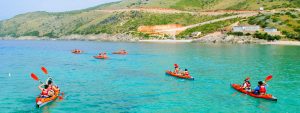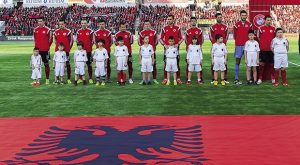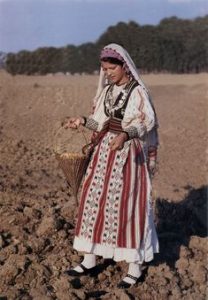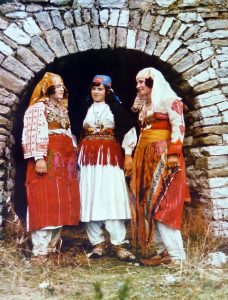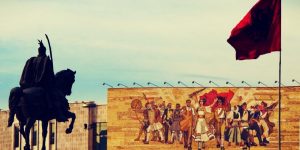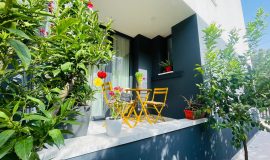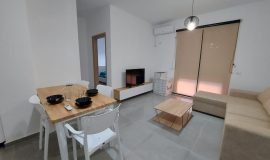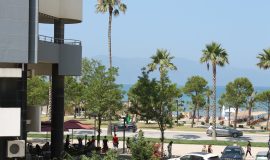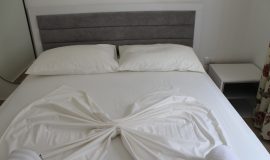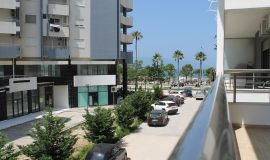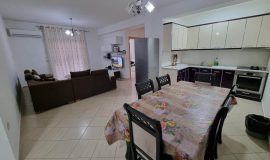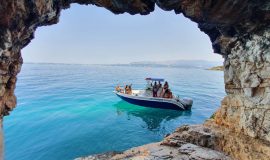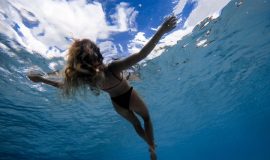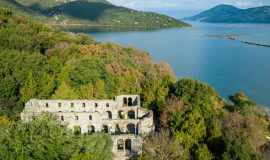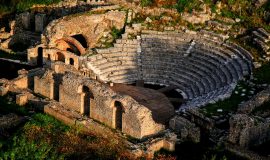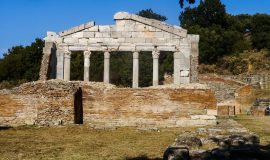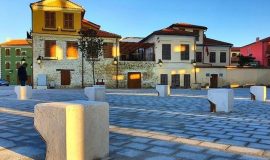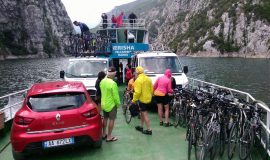Alternative Names
The international terms "Albania" and "Albanian" are based on the root
*alb- ,
*arb- , which also is the source of the word
Arberesh , which is used to describe the Italo-Albanians of southern Italy. That root also appears as
*lab- in
Labëria , referring to the southern Albanian region from Vlorë southward to the Greek border, and
*rab- in early Slavic, as in
raban ,
rabanski ("Albanian"). Also related to this basic root are the Turkish and Greek words for Albanians and the Albanian language. Albanians now use the designation
shqiptar ("Albanian")
shqip ("Albanian language"), and
Shqipëria ("Albania").
Orientation
Identification. According to the Austrian linguist Gustav Meyer (1850–1900),
shqip ("Albanian language"),
shqiptar ("Albanian"), and
Shqipëria ("Albania") are related to the Albanian verb
shqipoj ("to speak clearly") and
shqiptoj ("to pronounce") and can be linked to the Latin
excipio and
excipere ("to listen to, take up, hear"). The Albanologist Maximilian Lambertz (1882–1963) preferred a connection with the Albanian
shqipe or
shqiponjë ("eagle"), which is the symbol of Albania. The latter explanation may, however, simply be a folk etymology or constitute the reason why Albanians identify themselves with the eagle.
Albanians can be divided into two cultural groups: the northern Albanians, or Ghegs (sometimes spelled Gegs), and the southern Albanians, or Tosks. The geographic border between the two groups, based on dialect, runs roughly along the Shkumbin River, which flows through the central town of Elbasan to the Adriatic Sea. All Albanians north of the Shkumbin, along with the Albanians of Montenegro, Kosovo, and most of Macedonia (FYROM), speak Gheg dialects with their characteristic nasalization. All Albanians south of the Shkumbin, including the Albanians of Greece, southwestern Macedonia, and southern Italy, speak Tosk dialects with their characteristic rhotacism. Although dialect and cultural differences between the Ghegs and Tosks can be substantial, both sides identify strongly with the common national and ethnic culture.
Location and Geography. Albanians live in ethnically compact settlements in large areas of the southwest part of the Balkan peninsula, primarily in the Republic of Albania with its centrally located capital city of Tirana and in the self-proclaimed Republic of Kosovo. The Republic of Albania, which houses only about 60 percent of all the Albanians in the Balkans, is a mountainous country along the southern Adriatic coast across from the heel of Italy. Among the minority groups living with the Albanian majority are ethnic Greeks, Slavs, Aromunians (Vlachs), and Rom (Gypsies). Albania is bordered to the north by the Yugoslav republic of Montenegro, which has an approximate 10 percent Albanian minority living in regions along the Albanian-Montenegrin border. The Montenegrin towns of Ulcinj, Tuz, Plava, and Gucinj were traditionally and are still inhabited by Albanians. To the northeast of the Republic of Albania is Kosovo, still a de jure part of the Federal Republic of Yugoslavia. Kosovo, which the Kosovo Albanians have declared to be a free and sovereign republic and which the Serbs insist must remain an integral part of Serbia, has about 90 percent Albanian speakers and 10 percent Serb speakers, with minorities of Turks, Rom, Montenegrins, Croats, and Cherkess. The Albanian enclaves of Presheva (Presevo) and Bujanovc (Bujanovac) are in southern Serbia, not far from Kosovo. To the east of the Republic of Albania is the former Yugoslav Republic of Macedonia, one-third of which, along the Albanian border, has an Albanian majority. The central Macedonian towns of

Albania
Skopje, Kumanovo, and Bitola have sizable (15 to 50 percent) communities of Albanian speakers, whereas the western Macedonian centers of Tetova (Tetovo), Gostivar, and Dibra (Debar), along with the Struga area, all have an Albanian majority. The Albanians in Macedonia represent about 30 percent of the population, although there are no reliable statistics. The Albanian minority in Greece can be divided into two groups: those living in villages and settlements near the Albanian border and the largely assimilated Arvanites who populated much of central and southern Greece in the late Middle Ages. The Albanian language, known there in Albanian as
arbërisht and in Greek as
arvanitika , is still spoken to some extent in about three hundred twenty villages primarily in Boeotia (especially around Levadhia), southern Euboea, Attica, Corinth, and northern Andros. Southern Italy also has a substantial Albanian minority, known as the Arberesh, who are the descendants of refugees who fled from Albania after the death of Scanderbeg in 1468. Most of the Arberesh live in the mountain villages of Cosenza in Calabria and in the vicinity of Palermo in Sicily. In addition to these traditional settlements, there are large communities of Albanian emigrants in Greece, Italy, Switzerland, and Germany.
Demography. There are an estimated six million Albanians in Europe. The 1991 census for the Republic of Albania gives a total population of 3,255,891. In addition there are about two million Albanians in Kosovo, about five-hundred thousand in the Republic of Macedonia, and about one-hundred thousand in Montenegro. It is estimated that about one-hundred thousand people from the traditional Italo-Albanian communities in southern Italy can still speak Albanian. Figures for Albanian settlements in Greece are unavailable because the Greek government does not acknowledge the existence of an Albanian minority there. All these figures are estimates and fluctuate because of the extremely high birthrates of Albanians and the high level of emigration from Albania and Kosovo. An estimated three-hundred thousand emigrants from Albania now live in Greece, and about two-hundred thousand reside in Italy. In addition, there are about two-hundred thousand Albanians, mostly from Kosovo, living in central Europe (mainly Switzerland and Germany). In the last ten years, Albanians have emigrated to most other countries in Europe, as well as the United States, Canada, and Australia.
Linguistic Affiliation. The Albanian language,
shqip , is Indo-European, although it is not a member of any of the major branches of the Indo-European family. Despite its Indo-European affiliation and presence in the Balkans since ancient times, it is difficult to pinpoint the exact ancestry of the Albanian language because of the radical transformations that have taken place within it through the centuries. Among these transformations has been a substantial reduction in word length and extreme morphological alterations. Whether the Albanian language stems from Illyrian or Thracian, both, or neither is a matter of contention. The theory of the Illyrian origin of the Albanian people is the one most widely accepted in Albania and has been raised to the level of a national and state ideology. There is little evidence to prove or disprove this theory, since little is known about the Illyrian language. Since ancient times, very substantial strata of Latin and of Slavic and Turkish have been added to Albanian, making the older strata more difficult to analyze.
Albanian is a synthetic language that is similar in structure to most other Indo-European languages. Nouns are marked for gender, number, and case as well as for definite and indefinite forms. The vast majority of nouns are masculine or feminine, though there are a few neuter nouns. The nominal system distinguishes five cases: nominative, genitive, dative, accusative, and ablative; the genitive and dative endings are always the same. Attributive genitives are linked to the nouns they qualify by a system of connective particles. Albanian verbs have three persons, two numbers, ten tenses, two voices, and six moods. Unusual among the moods is the admirative, which is used to express astonishment. Among other particular features of Albanian and other Balkan languages are a postpositive definite article and the absence of a verbal infinitive. Although Albanian is not directly related to Greek, Serbo-Croatian, Romanian, or Bulgarian, it has much in common with all those Balkan languages after centuries of close contact.
The regional variants of spoken Albanian differ such that verbal communication between uneducated speakers of different dialects can be difficult. To overcome these problems, a standard literary language,
gjuha letrare , was agreed on at an orthography congress in Tirana in late November 1972 and has been in use for the last three decades in virtually all publications and in education throughout Albania, Kosovo, and Macedonia. This Standard Albanian is based about 80 percent on Tosk dialect forms, reflecting the structure of political power at that time in communist Albania. The subject remains controversial, with northern intellectuals having reopened in recent years the possibility of reviving a literary standard for the Gheg dialect. The
gjuha letrare seems to be a widely accepted standard and probably will survive the current turmoil.
Most Albanian speakers in Albania are monolingual, although in view of the strong cultural influence of Italian television, Italian is widely understood along the Adriatic coast. Greek not only is spoken by members of the Greek minority in southern Albania but also is understood by many Albanians near the Greek border. Most Kosovo Albanians speak and understand Serbo-Croatian.
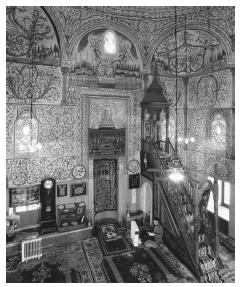
Prayer room at the Mosque of Etem Bay, in the capital city at Tirana.
Ironically, because the Belgrade authorities willfully destroyed the Albanian-language educational system in Kosovo in the mid-1980s, an increasing number of young people there, educated in "underground" schools, no longer speak and understand Serbo-Croatian.
Symbolism. The national and ethnic symbol of the Albanians is the eagle, which was used in that capacity in the earliest records. The eagle appears in a stone carving dating from 1190, the time of the so-called first Albanian principality, known as Arbanon, and was used as a heraldic symbol by a number of ruling families in Albania in the late Middle Ages, including the Castriotta (Kastrioti), the Muzakaj (Myzeqe), and the Dukagjini. A black double-headed eagle also was placed by the national hero Scanderbeg on his flag and seal. This form of the eagle, deriving from the banner of the Byzantine Empire, has been preserved as an ethnic symbol by the Arberesh of southern Italy. In the late nineteenth century, the double-headed eagle was taken up by the nationalist movement as a symbol of resistance to the Ottoman Empire and was used on the banners of freedom fighters seeking autonomy and independence. The current flag, bearing this black double-headed eagle on a red background, was officially raised on 28 November, 1912 to mark the declaration of Albanian independence in Vlorë and has been used since that time by the Republic of Albania and by Albanians everywhere as the national symbol.
In Albanian oral literature and folklore, the eagle appears as a symbol of freedom and heroism, and Albanians often refer to themselves as the "Sons of the Eagle." The popularity of the eagle among Albanians derives from the similarity between the words
shqipe (eagle) and the terms for the Albanian language, an Albanian person, and Albania.
Another beloved symbol is the Albanian prince and national hero Scanderbeg (1405–1468). His real name was George Castriotta (Gjergj Kastrioti). Sent by his father as a hostage to the Turkish Sultan Murad II (ruled 1421–1451), he was converted to Islam and, after being educated in Edirne, was given the name Iskander (Alexander) and the rank of bey. In 1443, after the Turkish defeat at Nish by John Corvinus Hunyadi (1385–1456), Scanderbeg abandoned the Ottoman army, returned to Albania, and embraced Christianity. He took over the central Albanian fortress of Kruja and was proclaimed commander in chief of an independent Albanian army. In the following years, Scanderbeg successfully repulsed thirteen Ottoman invasions and was widely admired in the Christian world for his resistance to the Turks, being accorded the title
Athleta Christi by Pope Calixtus III (ruled 1455–1458). Scanderbeg died on 17 January 1468 at Lezha (Alessio), and Albanian resistance collapsed a decade afterward. In 1478, his fortress at Kruja was taken by the Turks, and Albania experienced four centuries of Ottoman rule. For Albanians, Scanderbeg is the symbol of resistance to foreign domination and a source of inspiration in both oral and written literature. It is common in the homes of Albanian families living abroad to find not only an Albanian flag but also a bust or portrait of Scanderbeg.
History and Ethnic Relations
Emergence of the Nation. Albanians are a native Balkan people, although their exact origin is unclear. The national ideology insists on an unequivocal ethnic relationship with the ancient Illyrians. As little is known about the Illyrians and there are no historical records referring to the existence of the Albanian people during the first millennium
C .
E ., it is difficult to affirm or deny the relationship. Albanians entered postclassical recorded history in the second half of the eleventh century, and only in this age can one speak with any degree of certainty about the Albanian people as they are known today. In his
History written in 1079–1080, the Byzantine historian Michael Attaleiates was the first to refer to the
Albanoi as having taken part in a revolt against Constantinople in 1043 and to the
Arbanitai as subjects of the duke of Dyrrachium. Similarly, the historian John Scylitzes refers (ca. 1081) to the Arbanites as forming part of the troops assembled in Durrës by Nicephorus Basilacius. It can be assumed that the Albanians began expanding from their mountain homeland in the eleventh and twelfth centuries, initially taking possession of the northern and central coastline and by the thirteenth century spreading southward toward what are now southern Albania and western Macedonia. In the middle of the fourteenth century, they migrated farther south into Greece, initially into Epirus, Thessaly (1320), Acarnania, and Aetolia. By the middle of the fifteenth century, which marks the end of this process of colonization, the Albanians had settled in over half of Greece in such great numbers that in many regions they constituted the majority of the population. Despite these extensive settlements, the Albanians, largely a herding and nomadic people, do not seem to have created any substantial urban centers. There were no noticeable Albanian communities in the cities of the Albanian coast during the Middle Ages. Durrës was inhabited by the Venetians, Greeks, Jews, and Slavs; Shkodra, by the Venetians and Slavs; and Vlorë, by the Byzantine Greeks. It is estimated that a considerable proportion of Albanians were assimilated by the time of the Turkish invasion; in other words, the Albanians had been largely marginalized in their own country. Only during the Ottoman period did they began to settle in towns and acquire some of the characteristics of a nation rather than those of nomadic tribes.
National Identity. Until the nineteenth century, collective identity in Albania, as elsewhere in the Balkans, was defined primarily by religion, reinforced at the state level by the Ottoman precept of the
millet : To be of the Islamic faith was to be Turkish, and to be of the Orthodox faith was to be Greek. There was little room in either culture for the rising aspirations of Albanian nationalism during the national awakening (
Rilindja ) in the second half of the nineteenth century. During this period, nationalist leaders began to understand the divisive effects of religion among their people. The nationalist statesman Pashko Vasa (1825–1892) proclaimed in a widely read poem: "Albanians, you are killing your brothers, / Into a hundred factions you are divided, / Some say 'I believe in God,' others 'I in Allah,' /

A historical cemetery of martyrs overlooking the city of Korcë. Many graves date back to the independence movement of the early twentieth century.
Some say 'I am Turk,' others 'I am Latin,' / Some 'I am Greek,' others 'I am Slav,' / But you are brothers, all of you, my hapless people! .... Awaken, Albania, wake from your slumber, / Let us all, as brothers, swear a common oath / Not to look to church or mosque, / The faith of the Albanian is Albanianism!" The last line was taken up by Albanians everywhere as the catchword of the nationalist movement that led to independence in 1912.
Ethnic Relations. The Balkan peninsula is inhabited by a multitude of ethnic groups, and relations among them have never been good. Exacerbated nationalism and age-old rivalry for territory and supremacy have always created ethnic tension. This is especially true in regions with mixed settlement patterns, where ethnic groups are not separated by clear-cut political borders. While ethnic relations between Albanians and Greeks along their common border have improved substantially over the last decade, that cannot be said of relations between Albanians and their Slavic neighbors in the former Yugoslavia. In Kosovo, the Albanian majority was reduced to the status of an oppressed colonial people after the Serb conquest of the region at the beginning of the twentieth century. The open conflict that broke out in 1997 was, however, not initially one between Kosovo Albanians and Kosovo Serbs but between Kosovo Albanians and a hostile Serb regime in Belgrade. Relations between Albanians and Macedonians in the western part of the Republic of Macedonia have been tense since the declaration of Macedonian independence and the downgrading of the status of Albanians there to that of a "national minority."
Urbanism, Architecture, and the Use of Space
The traditional architecture of Albania almost disappeared during the Stalinist dictatorship of 1944– 1990. The old towns and bazaars of Tirana and many other urban centers were demolished and replaced by socialist prestige objects or uniform housing blocks. In the late 1960s and early 1970s, virtually all the churches and mosques were razed or transformed beyond recognition. The Catholic cathedral of Shkodra, for instance, was transformed into a sports hall with a volleyball court, and that of Tirana into a movie theater. With the exception of Berat and Gjirokastër, which were declared museum cities, little of the traditional flavor of Albanian towns can now be found. Most of the older public buildings that survived the communist period in Tirana, such as the main government ministries
and the university, date from the Italian period (1930s–1940s). The main thoroughfare of Tirana from Scanderbeg Square to the university was constructed by the Italians as a symbol of Italian fascism. The lack of zoning regulations led in the 1990s to chaos in construction and the use of space, destroying the little that survived the communist regime. Old villas have been demolished, and most parks and public gardens disappeared under a myriad of kiosks and cafés.
Food and Economy
Food in Daily Life. After half a century of Stalinist dictatorship, food culture is virtually nonexistent. For decades, there was little on the market beyond basic staples, and today, dire poverty has left most Albanians with little more to eat than bread, rice, yogurt, and beans. In as much as it has survived at all, Albanian cuisine is meat-oriented. Traditional dishes, which usually are reserved for guests and special occasions such as weddings, are easier to find among Albanians living abroad.
Food Customs at Ceremonial Occasions. Despite their poverty, Albanians are exceptionally generous and hospitable. A person invited to dinner will be given enough to "feed an army," even though the host may go hungry the next day. It is not unusual for an Albanian family to spend a month's salary to feed a visitor. Meals for guests or for ceremonial occasions such as weddings usually involve copious amounts of meat, washed down with Albanian raki , an alcoholic beverage. Animals were formerly slaughtered and roasted on a spit for religious holidays such as the Muslim celebration of Great Bayram and the Christian feast days of Saint Basil on 1 January, Saint Athanasius on 18 January, Saint George on 23 April and 6 May, Saint Michael on 29 September, Saint Nicholas on 6 December, and Christmas on 25 December. These customs have largely died out, although some regional dishes have survived. The Orthodox of southeastern Albania still eat qumështor , a custard dish made of flour, eggs, and milk, before the beginning of Lent. During the annual spring festival ( Dita e Verës ), in central Albania on 14 March, the women of Elbasan and the surrounding regions bake a sweet cake known as ballakum Elbasani . Members of the Islamic Bektashi sect mark the end of the ten-day fasting period of matem with a special ashura (pudding) made of cracked wheat, sugar, dried fruit, crushed nuts, and cinnamon.
Basic Economy. Until 1990, Albania had a centralized socialist economy dominated by agricultural production on state farms. Food was in short supply, and despite communist propaganda, the country never attained self-sufficiency. While Albania still has a large rural peasantry, traditionally over 60 percent of the total population, most families in the countryside can do little more than feed themselves. Some farming surplus has reached urban markets in recent years, but food imports remain essential.
Land Tenure and Property. Albania is a mountainous country with an extremely high birthrate, and there is not enough farmland. Agriculture was reprivatized in the early 1990s after the fall of the communist regime, and many properties were returned to their former owners. Most families, however, received extremely small plots barely large enough to survive on. Property disputes are common and have been a major cause of blood feuding. Although most political parties have strategies for the further privatization of industry and nonagricultural land, many problems remain.
Commercial Activities, Major Industries, and Trade. Aside from agricultural output, Albania is a major producer of chrome. There are also significant deposits of copper and nickel and some oil. The country is still reeling from the radical transformation from a socialist to a free market economy, and commercial activity has not attained its potential. Virtually all the major industries went bankrupt and collapsed in the early 1990s when a free market economy was introduced. Some mines, chrome in particular, are still in production, but most have stagnated under pressure from foreign competition. Among the few sectors of the economy that are doing well is the construction industry. Domestic building materials are now widely available on the local market and increasingly on foreign markets. The European Union is the major trading partner, with Italy, Greece, and Germany leading in imports and exports. The national trade deficit has been compensated to some extent by foreign exchange remittances from Albanian emigrants working abroad.
Social Stratification
Classes and Castes. Under the communist regime, which called for absolute equality and the rule of a single working class, there were in fact three social castes. The ruling caste was composed of the extended families of politburo members and related communist families and clans. The majority of the population was in the working class. The
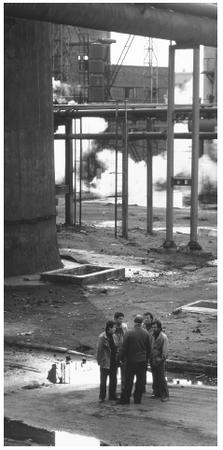
Workmen at a metallurgical plant in Elbasan, Albania. Much of the Albanian industrial sector collapsed with the introduction of a free market economy in the early 1990s.
lowest caste consisted of once prosperous farming families, the precommunist middle class, and opponents of the regime. Many of those families were sent to the countryside into internment or internal exile and were denied access to many professions and to education for their children. This caste system broke down with the fall of the communist regime and has been replaced by a system where status is determined exclusively by wealth.
Political Life
Government. The Republic of Albania is a parliamentary republic with a democratic constitution that was promulgated in 1998. Political turmoil has continued since the ousting of the authoritarian Berisha regime in 1997, and there is little sign of consensus or cooperation between the ruling and opposition parties. Political tension remains high.
Leadership and Political Officials. The current president, Rexhep Meidani, is a former university professor from the ruling Socialist Party. The government coalition, now under the leadership of Prime Minister Ilir Meta, is dominated by the Socialist Party. Former president Sali Berisha of the Democratic Party continues to lead the opposition.
Social Problems and Control. Public order broke down in 1997 as a result of a lack of political and economic planning. During the spring of 1997, arms depots were plundered throughout the country; as a result, crime became a major problem. Since the 1997 breakdown, there has been a substantial degree of taking the law into one's own hands. However, this is not a new phenomenon but part of Albanian tradition. For centuries, it was not the central government but Albanian customary or traditional law that governed social behavior and almost every facet of life in northern Albania. This customary law is widely respected today. In its definitive form, the Kanun of Lekë Dukagjini had chapters covering church; the family; marriage; house, livestock, and property; work; transfer of property; the spoken word; honor; damages; crimes; judicial law; and exemptions and exceptions. It was strictly observed by the tribes of the northern highlands and had priority over all other laws, ecclesiastical or secular. With the help of this ancient code, the highland tribes were able to preserve their identity, autonomy, and way of life under the Ottoman Empire for five centuries. Some aspects of the Kanun may appear harsh to a modern observer. Vengeance, for instance, was accepted as the prime instrument for exacting and maintaining justice. This led to blood feuding that decimated the northern tribes in the early years of the twentieth century and that is again a major problem of social life in northern Albania.
Gender Roles and Statuses
The Relative Status of Women and Men. Albania is a patriarchal society based on male predominance. Women are accorded subordinate roles. The communist Party of Labor did much to emancipate women during a revolutionary campaign in the late 1960s and early 1970s, but many of the gains of that social revolution have been reversed since the introduction of democracy and a free market economy. Old traditions have revived, and despite legal equality and acceptance in the workforce, women have much less representation in public life than they did under the former regime.
Marriage, Family, and Kinship
Marriage. Marriages in Albania are socially and legally restricted to heterosexual couples. They often are arranged at an early age in the countryside, traditionally by the parents of the groom with the help of a matchmaker rather than by the couple. Remaining unmarried is looked on as a great misfortune. In some mountain regions, the bride was stolen from her family, that is, spirited away by an armed bridegroom or by his male relatives and companions. This usually symbolic though occasionally real theft of a bride was also a common custom among the Italo-Albanians of Calabria. In other regions, it was customary to purchase a wife. In zones such as Mirditë and the northern mountains, the father, brother, or another male relative of the bride still presents the groom with a bullet wrapped in straw. The new husband is thus free to kill his wife with the approval of her family if she proves to be disobedient.
Albanian weddings are impressive festivities. They are virtually the only popular celebrations observed today and thus are taken very seriously. Whole villages and, in towns, hundreds of people may be invited to take part in a wedding banquet. The celebrations can last several days. Traditionally, weddings take place during the full moon to ensure offspring. Monogamy was always the rule in Albania, but polygamous marriages existed up to the beginning of the twentieth century in some areas, particularly if the first wife was not able to bear a son. Live-in concubines were not uncommon in the mountains up to World War II. Albanian women were as a rule faithful to their husbands. Since a wife was considered the property of her husband, adultery amounted to theft. Thus, cases of adultery were punished severely under traditional law. Premarital and extramarital sex was more prevalent in the northern highlands, the part of the country with the most rigid moral code. Divorce is now a common phenomenon.
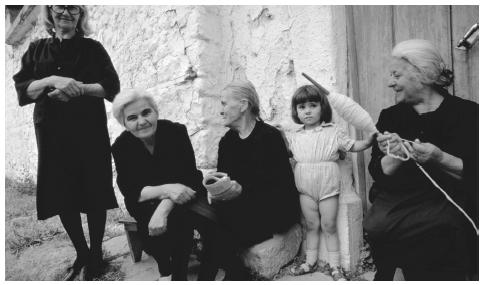
A group of women near Korcë. In Albania's patriarchal society, women are generally placed in subordinate roles.
Socialization
Child Rearing and Education. Albanians have always lived in a world of extreme hardship and deprivation. Underdevelopment and a high incidence of infant mortality have been compounded by warring and blood feuding that at times decimated the male population. Reproduction, as the key to survival, therefore took on a more elementary significance among Albanians than it did among neighboring peoples. Even today, Albanian birthrates are significantly higher than those anywhere else in Europe. As in other third world cultures, it is believed that the more children, especially male children, one raises, the more security one will have in one's old age. A childless marriage is considered a great misfortune, and a woman living without a husband and children is inconceivable.
Given the extremely patriarchal nature of Albanian society, greater importance is attributed to the birth of sons than to that of daughters. Even today, pregnant women are greeted with the expression të lindtënjëdjalë ("May a son be born"). In Mirditë and the mountains of the north, the birth of a son was marked by rejoicing throughout the tribe and the firing of rifles. It was often the custom in the north of Albania for a woman to be wed officially only after she had given birth to her first son. In Berat, the main beam of a house was painted black at the birth of a girl as a token of the family's disappointment.
Male children generally were better treated, for instance, by being better protected against the "evil eye." As the Kosova scholar Mark Krasniqi (born 1920) points out, boys are given names such as Ujk ("Wolf"), Luan ("Lion"), and Hekuran ("The Iron One"), whereas girls are named Mjafte ,or Mjaftime ("Enough"), Shkurte ("The Short One"), Mbarime ("The Last One"), and Sose ("The Final One").
Religion
Religious Beliefs. Albania is on the border dividing three religions: Roman Catholicism, Greek Orthodoxy, and Islam. According to the last reliable statistics on religion (1942), among a population of 1,128,143, there were 779,417 (69 percent) Muslims, including the Bektashi; 232,320 (21 percent) Orthodox; and 116,259 (10 percent) Catholics. One can estimate today that approximately 70 percent of Albanians in the republic are of Muslim, including Bektashi, background; about 20 percent, mostly in the south, are Orthodox; and about 10 percent, mostly in the north, are Catholic. In 1967, all religious communities were dissolved when a communist government edict banned the public practice of religion. The law was rescinded only in December 1990 during the collapse of the regime. Despite the return of religious freedom, there seems to be more interest in the revival of Christianity and Islam among foreign missionaries and groups than there is among Albanians. Albanians have never had a national religion with which to identify as a people. For the last century and a half, national (ethnic) identity has predominated over religious identity, and this is unlikely to change in the coming years in a small and struggling nation surrounded by hostile neighbors. Organized religion still plays only a marginal role in public life. Religious fervor is extremely rare, and religious extremism is virtually unknown.
The Arts and Humanities
Literature. The foundations of a national literature were laid in the second half of the nineteenth century with the rise of a nationalist movement striving for Albania's independence from a decaying Ottoman Empire. The literature of this so-called Rilindja period of national awakening was characterized by romantic nationalism and provides a key to an understanding of the Albanian mentality today.
At the beginning of the twentieth century, the Catholic education facilities set up by the Franciscans and Jesuits in Shkodra under the auspices of the Austro-Hungarian Kultusprotektorat paved the way for the creation of an intellectual élite that produced the rudiments of a more sophisticated literature which expressed itself primarily in poetry. The culmination of Albanian literature before World War II appears in the works of the Franciscan priest Gjergj Fishta (1871–1940), once lauded as the national poet. From 1945 to 1990, for primarily political reasons, Fishta was ostracized from the Albanian literary world and the mention of his name was forbidden.
Virtually all prewar Albanian literature was swept away by the political revolution that took place during and after World War II. Most prewar writers and intellectuals who had not left the country by 1944 regretted their decision to stay. The persecution of intellectuals and the break with virtually all cultural traditions created a literary and cultural vacuum that lasted until the 1960s and whose results can still be felt.
With Albania's integration into the Soviet bloc during the 1950s, Soviet literary models were introduced and slavishly imitated. Writers were encouraged to concentrate their creative energies on specific themes, such as the partisan struggle of the "national liberation war" and the building of socialism. Despite the constraints of socialist realism and Stalinist dictatorship, Albanian literature made much progress in the 1970s and 1980s. One of the best examples of creativity and originality in Albanian letters then and now is Ismail Kadare (b. 1936), the only Albanian writer with a broad international reputation. Kadare's talents both as a poet and as a prose writer have lost none of their innovative force over the last three decades. His influence is still felt among the young postcommunist writers of the 1990s, the first generation to be able to express itself freely.
Bibliography
Carver, Robert. The Accursed Mountains: Journeys in Albania , 1998.
Durham, Edith. High Albania , 1909 (reprint 1970, 1985).
Elsie, Robert. Anthology of Modern Albanian Poetry: An Elusive Eagle Soars , 1993.
——. Albanian Folktales and Legends , 1994.
——. History of Albanian Literature , 1995.
——. Studies in Modern Albanian Literature and Culture , 1996.
——. Kosovo: In the Heart of the Powder Keg , 1997.
Gjeçovi, Shtjefën. The Code of Lekë Dukagjini , translated by Leonard Fox, 1989.
Jacques, Edwin E. The Albanians: An Ethnic History from Prehistoric Times to the Present , 1995.
Kadare, Ismail. The General of the Dead Army , 1986.
——. Chronicle in Stone , 1987.
——. Doruntine , 1988.
——. Broken April , 1990.
——. The Palace of Dreams , 1993.
——. Albanian Spring: The Anatomy of Tyranny , 1994.
——. The Concert , 1994.
——. The Pyramid , 1996.
——. The File on H , 1997.
——. The Three-Arched Bridge , 1997.
Malcolm, Noel. Kosovo: A Short History , 1998.
Newmark, Leonard. Albanian-English Dictionary , 1998.
Pettifer, James. Blue Guide Albania , 2nd ed., 1996.
Pipa, Arshi. The Politics of Language in Socialist Albania , 1989.
——. Albanian Stalinism: Ideo-Political Aspects , 1990.
——. Contemporary Albanian Literature , 1991.
—— and Sami Repishti, eds. Studies on Kosova , 1984.
Prifti, Peter. Socialist Albania since 1944 , 1978.
Skendi, Stavro. Albania , 1956.
Vickers, Miranda. Albania: A Modern History , 1994.
——. Between Serbs and Albanians: a History of Kosovo , 1998.
—— and James Pettifer. Albania: From Anarchy to a Balkan Identity , 1996.
Zymberi, Isa. Colloquial Albanian , 1991.
—R OBERT E LSIE
Read more:
https://www.everyculture.com/A-Bo/Albania.html#ixzz6E0cFilhj
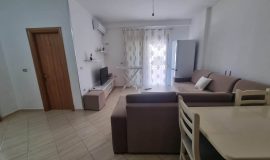
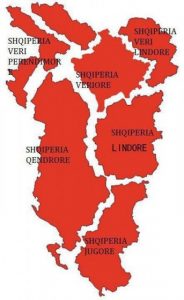 Where is Albania?
Where is Albania?
